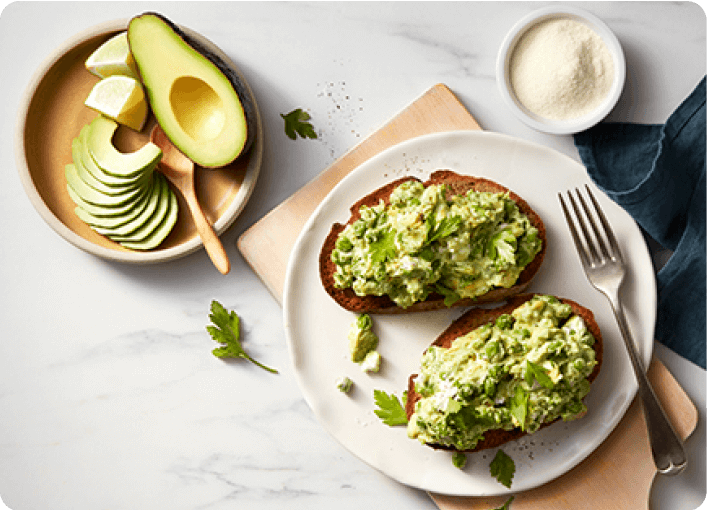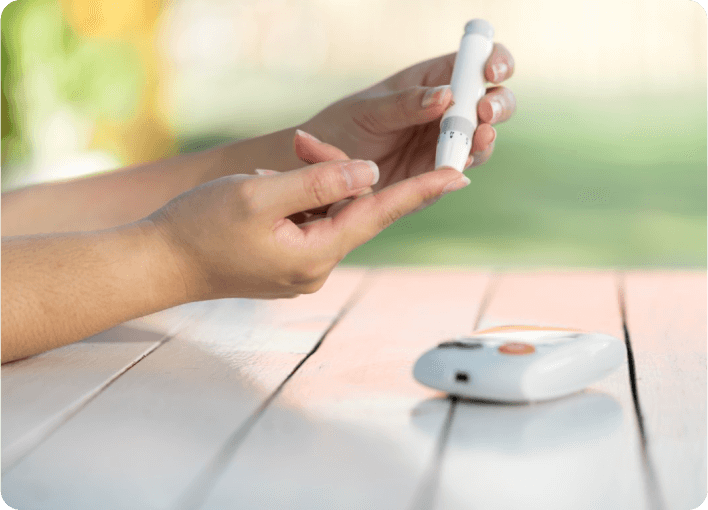Low-GI
Glucerna powder (mixed with water) has a GI of 35 (Vanilla) and 29 (Chocolate), and Ready-to-Drink (liquid) Glucerna has a GI of 27.5-7
Having diabetes doesn’t mean giving up all your favourite foods. The first step to making smarter choices is to separate the diet myths from the facts.
Fact: You can still enjoy your favourite sweet treats if you plan properly and limit hidden sugars. You can include dessert sometimes, as long as it’s in small amounts and part of a healthy meal plan.1
Myth: You must cut your carbs dramatically
Fact: A lower carbohydrate diet may be helpful for some people with diabetes, but not all – speak to your healthcare team if you are considering reducing your carbohydrates. As well as the serving size, the type of carbohydrates you eat is key. Consider focusing on eating moderate amounts of high fibre, low glycaemic index (low-GI), carbohydrates. These help keep blood sugar levels more even than high-GI carbohydrates.2
Fact: A healthy diet means eating a variety of foods from different food groups. It should include a good balance of protein, carbohydrates and fats, as our bodies need all three to function properly.1 Read on to find out more.
A healthy diet is one that is packed with fresh fruits and vegetables, and includes lots of fibre, low-GI carbohydrates (such as wholegrain breads, cereals, beans, lentils and other legumes), low-fat dairy products and lean proteins (such as lean red meat, lean chicken and fish).
Diabetes Australia recommends people with diabetes follow the Australian Dietary Guidelines as a starting point, as well as seeing an accredited practicing dietitian for individualised advice.1
For more information visit the Australian Dietary Guidelines
Portion control is crucial in managing diabetes. Even when planning and preparing a healthy meal, it is important to consider portion size of different foods.
About ¼ of your plate should be filled with low-GI carbohydrates: grain or a starchy food such as a low-GI basmati rice, wholegrain pasta or corn.
¼ of your plate should be filled with lean protein including lean red meat, fish, skinless chicken or tofu.
The last ½ of your plate should be filled with raw/cooked vegetables or salad like broccoli, carrots, salad, and/or beans.
A quick way to help visualise portion sizes is by dividing your plate into three sections and filling it as shown below.3
Glucerna is a health shake that is specially formulated to support people living with diabetes or impaired glucose tolerance, as part of a diabetes management plan including diet and exercise.4
Glucerna powder (mixed with water) has a GI of 35 (Vanilla) and 29 (Chocolate), and Ready-to-Drink (liquid) Glucerna has a GI of 27.5-7
Clinically shown to provide a steady release of glucose, helping you minimise your blood glucose spikes.*4,8–10
To help support insulin sensitivity.4,11–13
Glucerna can also be added to favourite recipes to boost the nutritional value of your food.†
Get inspired by recipes for delicious meals with the added nutrition of Glucerna:

Eating right when you have diabetes doesn’t have to be complex – it is about knowing what is best for you and your diabetes management plan. Knowing which foods are low-GI can be a helpful way of keeping track of your diet. Read on for a breakdown of what ‘low-GI carbohydrate’ means and how this might be helpful.

While there is no cure for diabetes, many treatments are available to help control blood glucose levels. A healthy lifestyle plays a big role in managing blood glucose levels and reducing the risk of complications.14 This article will explain briefly how type 2 diabetes is managed.

If you’ve been told you have pre-diabetes, or are worried you might, this page might help you get a better understanding of what that means.
Glucerna is Food for Special Medical Purposes. Use under medical supervision.
*Glucerna should be used as part of a diabetes management plan, including a healthy diet and physical activity.
†Please note when cooking with or freezing Glucerna, there may be minor loss of some nutrients.
References: 1. Diabetes Australia. Healthy diet for diabetes. Available at: https://www.diabetesaustralia.com.au/living-with-diabetes/healthy-eating/. Accessed May 2023. 2. Diabetes Australia. Carbohydrates, protein and fats. https://www.diabetesaustralia.com.au/living-with-diabetes/carbs-protein-fats/ Accessed May 2023. 3. Baker Heart and Diabetes Institute. Portion plate guide. Available at: https://www.baker.edu.au/health-hub/fact-sheets/the-portion-guide. Accessed May 2023. 4. Glucerna® Powder Product Label. 5. Glucerna® Y495 GI test result. 6. Glucerna® Y523 GI test result. 7. Glucerna® Y578 GI test result. 8. Devitt A, et al. Journal of Diabetes Research and Clinical Metabolism. 2012;1(1):20, 9. Mottalib A, et al. Nutrients. 2016;8(7):443, 10. Dávila LA, et al. Nutrients. 2019;11(7):1477. 11. Bevilacqua A, et al. Int J Endocrinol. 2018;2018:1968450. 12. Dang NT, et al. Biosci Biotechnol Biochem. 2010;74(5):1062–7. 13. Yamashita Y, et al. J Agric Food Chem. 2013;61(20):4850–4. 14. Better Health Channel. Diabetes. Available at: https://www.betterhealth.vic.gov.au/health/conditionsandtreatments/diabetes. Accessed May 2023.
Links which take you out of Abbott worldwide websites are not under the control of Abbott, and Abbott is not responsible for the contents of any such site or any further links from such site. Abbott is providing these links to you only as a convenience, and the inclusion of any link does not imply endorsement of the linked site by Abbott.
The website that you have requested also may not be optimized for your screen size.
Do you wish to continue and exit this website?


ANZ.2024.53720.ENS -GLU -PDS.1 (v1.0)